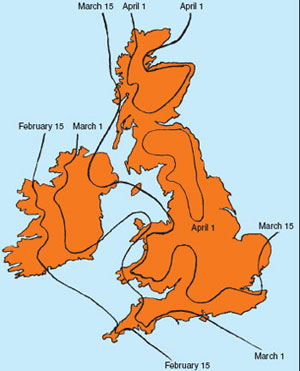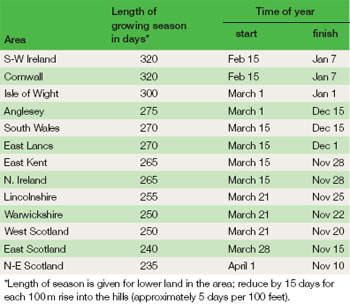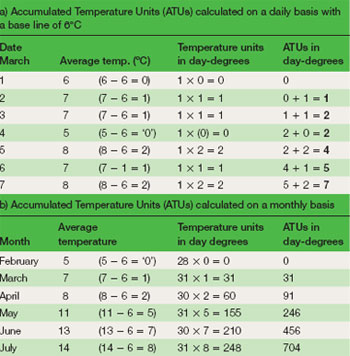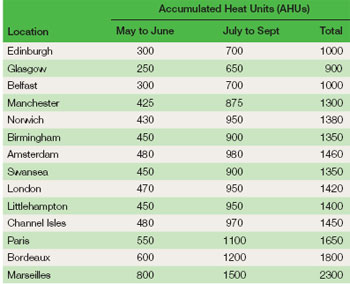The growing season
ContentThe outdoor growing season is considered to be the time when temperatures are high enough for plant growth. Temperate plants usually start growing when the daily mean temperatures are above 6°C. Spring in the southwest of the British Isles usually begins in March, but there is nearly a two-month difference between its start in this area and the northeast (see Figure 2.7).
In contrast, as temperatures drop below 6°C the growing season draws to a close. This occurs in the autumn, but in the southwest of England and the west of Ireland this does not occur until December, and on the coast in those areas there can be 365 growing days per year. Within the general picture there are variations of growth periods related to altitude, aspect, frost pockets, proximity of heat stores, shelter and shade: the so-called local climates and microclimates. However, for most of mainland UK, the potential growing season spans between eight and nine months. Examples are given in Table 2.1.
Proximity to the sea not only increases the length of the growing season, but also reduces its intensity, i.e. the extent to which temperatures exceed the minimum for growth. Although inland areas have a shorter season they become much warmer more quickly before cooling down more rapidly in the autumn. The differences in intensity can be expressed in terms of accumulated temperature units. Accumulated temperature units (ATUs) are an attempt to relate plant growth and development to temperature and to the duration of each temperature. There is an assumption that the rate of plant growth and development increases with temperature. This is successful over the normal range of temperatures that affect most crops. On the basis that most temperate plants begin to grow at temperatures above 6°C the simplest method accredits each day with the number of degrees above the base line of 6°C and accumulates them (note that negative values are not included). A second method calculates ATUs from weather records on a monthly rather than daily basis. Examples are given in Table 2.2.
Methods such as these can be used to predict likely harvest dates from different sowing dates. Growers may also use such information to calculate the sowing date required to achieve a desired harvest date. In the production of crops for the freezing industry, it has been possible to smooth out the supply to the factory by this method. For example, a steady supply of peas over six weeks can be organized by using the local weather statistics to calculate when a range of early to late varieties of peas (i.e. with different harvest ATUs) should be sown.
The accumulated heat unit concept can also be used to estimate greenhouse heating requirements by measuring the extent to which the outside temperature falls below a base or control temperature, called 'degrees of cold'. In January, a greenhouse maintained at 18°C at Littlehampton on the coast in Sussex accumulates, on average, 420 cold-degrees compared with 430 for the same structure inland at Kew, near London. For a hectare of glass this difference of 10 cold degrees C is the equivalent of burning an extra 5000 litres of oil. This provides a useful means of assessing possible horticultural sites when other data such as solar heating and wind speed are all brought together. Other methods based on this concept enable growers to calculate when different varieties of rhubarb will start growing and the energy requirements for chill stores and refrigeration units. |









